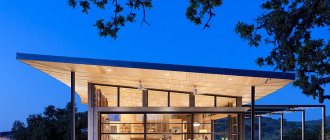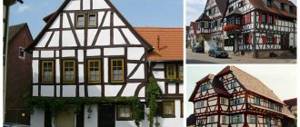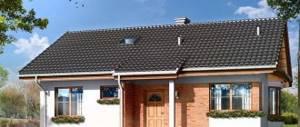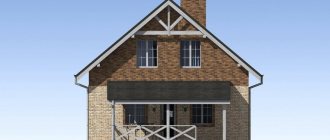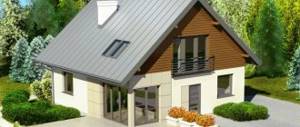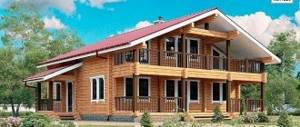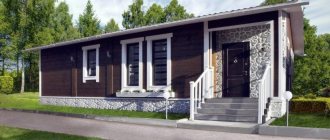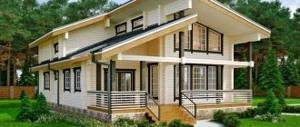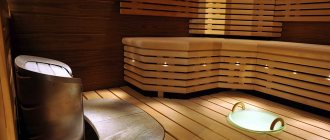Materials for building a house
There are many materials available on the construction market today. Choosing the best option is not so easy.
You need to start by analyzing the properties of each of them; you can choose the material whose price and quality will be optimal.
Before starting construction, you can look through a magazine, a catalog of construction companies with building options.
A house in which you plan to live permanently must be resistant to precipitation, be noise- and heat-insulated, and be a “fortress” for many years.
Video:
Brick, ceramic blocks, foam concrete, aerated concrete, logs and timber have similar properties.
A magazine with recommendations from a specialized company can tell you how much and what kind of material will be needed for construction.
Frame houses and their features
Also, if you are choosing which materials are cheaper to build a house from, you can opt for a frame house. Frame houses have a lot of advantages and benefits.
Frame construction technology occupies a leading place among those wishing to build their own home. Such a house is built using a special technology from durable and reliable SIP panels. It is distinguished by its attractive appearance, high quality, and fast assembly process. If you have decided to build a frame house, then you will need to find a company that will produce SIP panels of the sizes and technical characteristics you need.
As a rule, the walls of the house are manufactured at the manufacturer's factory. At this time, the builders prepare the foundation, and after that they put the panels into the structure on site. The construction phase ends with the erection of the roof. That's the whole simple process. If you have all the materials and carry out preparatory work, such as clearing the site and laying the foundation, it is possible to assemble a frame house within a few days. After this, it is worth installing windows, doors, interior partitions and you can begin interior repair and finishing work. Now it's time to enjoy a comfortable and pleasant life in your own home against the backdrop of picturesque nature.
Characteristics and properties of brick
The Building Materials Magazine is of the opinion that brick is durable and strong.
If you start construction according to all the rules, then it will last 100 years, and its residents will enjoy comfort and warmth.
The most common material for construction is brick, which has many properties:
- Completely natural;
- During construction work there is no need to use additional additives - “disintegrants”;
- The brick is not flammable; in the event of a fire, the brick box will remain intact. On its basis it will be possible to rebuild a new house;
- Brick is highly durable. Walls made from it will be able to withstand heavy shutters and an attic;
- Over time, on a one-story brick house, you can install several more floors and add additional rooms;
- The masonry is not subject to shrinkage or rotting;
- The rooms of the house always have a comfortable temperature - in the cold season the walls will retain heat, and in the heat they will protect from the heat.
When building a house from brick, it is worth considering not only the properties of this material. It is important to pay attention to the quality of the cement composition, the nature of the masonry, and insulation.
The magazine will be able to tell about the properties and types of materials. A set of indicators of all components will influence the quality factor of the house.
There are disadvantages to using bricks to build a house. The construction of the structure will take a long time, since the time of year and weather conditions play an important role during construction work.
In summer, the solution will dry out quickly, and in winter it may freeze. If it rains, construction will have to be delayed until it stops.
The construction magazine notes that it is important to pay attention to the masonry. The bricks must be laid evenly. Otherwise the house will not be strong.
For this reason, it is worth entrusting the construction of permanent residence to professionals, and this will cost the home owner a lot of money.
You can make the use of this type of building material cheaper - use it as cladding. The brick will decorate the walls of the building and protect it from adverse natural influences.
Video:
It is recommended to start building a brick house on a large, empty plot. During construction work you will need a lot of space.
After all, you need to dilute the cement mortar, lay down the bricks needed for construction, and collect the waste that is inevitably generated during the construction of a house.
If the site already has a landscaped garden or beds, this will complicate the work.
What is the cheapest material to build a permanent house from?
As already noted, a house that will stand for centuries is a priori expensive for its owner at the time of construction. However, for budget construction there is an innovation of recent decades - frame frames .
We recommend: Building a house using Velox technology - what are the features. Pros and cons of Velox stove on video
The lighter the walls, the cheaper it will cost. If you use inexpensive SIP panels, the price will become even lower. However, many are distrustful of the walls of the house, which can be pierced with a large knife using a lot of force.
from cellular concrete or thermal panels is the cheapest . Construction from bricks and ceramic blocks . For these buildings, the cost of work will be higher, since the blocks themselves are not easy to lift.
The same conditions will apply to the foundation: the more durable, stronger, the more expensive it will be both in terms of materials and labor costs. It is optimal for a small house to install a pile foundation ; if there is an idea to add a 2nd floor or a good attic, it is better to play it safe.
We recommend reading: Building a house using SIP technology
Features of foam blocks
When choosing materials for housing construction, ease of construction, environmentally friendly properties, thermal insulation, and sound insulation are taken into account.
Foam blocks have such qualities, which is why magazines and catalogs of construction companies often suggest choosing this particular material.
The blocks have advantages due to which they have conquered the market:
- Environmentally friendly - natural materials are used in its production. The proportion of plasticizers and dyes is so small that it will not harm health;
- Able to allow air to pass through, so a favorable climate will always be maintained in the house;
- Lightweight, which affects the speed of housing construction. In addition, there is no need to build a strong foundation;
- It has high levels of noise and heat insulation. There is no need to spend a lot of money on purchasing insulating materials or additional wall insulation;
- Able to withstand high temperatures;
- Its price is lower than other materials. Building a house will cost less than, for example, from brick or timber.
Walls made of foam blocks can be finished from any materials. The construction magazine offers options for decorating walls with plaster, decorative panels, and wallpaper.
A feature of foam blocks is its fragility. When transporting blocks to the construction site, they may be damaged, so it is worth paying special attention to the quality of transportation.
After they are laid, the blocks shrink. Its percentage is affected by the temperature difference during construction. To reduce it to a minimum, you need to use high-quality reinforcement during construction.
Video:
After installing a box made of foam blocks, you should not immediately begin finishing. It's all about the chemical reactions that will take place between carbon dioxide and cement.
Otherwise, cracks will form, which serve as cold bridges. As a result, the room will not retain heat.
Wood is an environmentally friendly material for building a house
A house for permanent residence, built from timber, is distinguished by its beauty and solidity.
Wood has many characteristics due to which it is most often chosen as a building material:
- high thermal insulation rates;
- environmentally friendly material - will not harm health;
- high heat resistance, thermal conductivity of timber;
- long service life.
Wooden beams can be cylindrical and glued. The magazine of specialized companies will tell you about the properties of each type. Masonry made from cylindrical timber will shrink over time.
As a result, the geometric shapes will change slightly, and thermal insulating material will need to be added to the joints and seams.
Glued laminated timber is resistant to deformation.
Photo:
It's all about its production: several layers of timber are placed under the press so that their radial rings of life are directed in opposite directions, and with the help of glue they are fastened together very firmly.
Its environmentally friendly properties are not inferior to cylindrical logs. Chemical antiseptics and varnishes are now being replaced with impregnations based on natural ingredients.
It can be beeswax, turpentine, propolis, patchwork wax. The last component is produced by domestic companies and is a high quality product.
Impregnations protect the surface of the timber from rotting, prevent the attack of insects, and increase the level of fire resistance.
One-story cottages and houses for permanent residence with several floors can be built from timber.
Video:
A variety of profile types of wood will allow you to create houses of various geometric shapes.
Options for buildings are presented in catalogs and magazines of construction companies. The building on the site will look modern.
For a wooden house it is not necessary to build a massive foundation; you can start by making it shallow. The walls also do not require additional external treatment.
The main advantage of wooden houses is the possibility of their construction at any time of the year.
Features of frame construction
Before building a frame house, you should start by forming the frame. It can be metal or wood.
More durable are metal frames, but their construction requires a lot of time. Wooden structures are assembled cheaper and faster.
The thickness of the wood blank depends on the insulation material and its thickness.
For external cladding, one of the following options is used: cement-bonded particle board, moisture-resistant plywood, or oriented strand board. Mineral wool or polystyrene foam is suitable as insulation.
Video:
One-story cottages are built very quickly. After the foundation has gained the necessary strength, you can assemble the home.
There is no need to wait weeks or months to complete finishing work. The frame structure does not shrink, so the construction of such a house will not take much time.
Frame houses have their advantages:
- Ease of construction - you can do without the help of builders. Using the instructions and recommendations, the frame house will stand on the site in a short time;
- The elements of a frame house are light in weight, so there is no need to use special devices or technical means;
- Due to the fact that the construction of such a house does not require the involvement of workers from construction companies or special equipment, the construction of housing will cost several times less than using other materials;
- Frame houses are highly stable. They will withstand not only foundation subsidence, but also earthquakes;
- They can be built at any time of the year. Frost and heat do not affect the quality of the finished structure;
- High heat and sound insulation. A frame house will be cool in summer and warm in winter. During the cold season, you can save on additional heating of the room. Layers of insulation will prevent the penetration of sounds from the street.
Such houses are suitable for permanent residence, but you need to be prepared to change the insulation of the building every 30-35 years.
A new way of building houses - monolithic construction
In modern construction, the construction of houses using a monolithic method is not yet common. The basis of the technology of this method is pouring concrete into the foundation and walls.
The structures are quite durable and have uniform properties.
The main advantage of monolithic houses is strength and durability.
The aesthetic component is very high. The magazine of construction companies that are engaged in the construction of such houses offers a lot of options for decorating a home with a variety of materials.
The house will be distinguished by its individuality and fully correspond to the tastes and needs of the owner.
Monolithic buildings have disadvantages. Their construction requires the use of special equipment, the formation of complex formwork, and when installing floors, it is necessary to create supports and stairs.
What material is better to build a house from yourself?
What material to choose, what is better and cheaper to build a house from? Let us give a brief overview of the types and types of private houses, as well as materials for their construction.
What are heavy and light materials?
Heavy materials for construction include, as the name suggests, stones, various blocks, bricks, slabs . Houses made of heavy materials also require an appropriate foundation. Most often, a strip type is used, but if the ground is not the best, it can be combined with a pile-screw type.
When it comes to lightweight materials, we mean wood and frames . Of course, these are just conventional names for such houses, which does not mean that the house will be really light in the end. It is better to choose the best possible foundation for wooden houses. Wooden houses last for several hundred years and the foundation should not fail.
For frames, you can save a little by choosing just the pile option . The shelf life of frame wood is up to 100 years, so if the soil allows you to save money, this is quite possible.
Brick is expensive, but lasts forever
As they say, a brick can handle anything: hurricanes, frosts, unbearable heat - the natural mood is changeable.
However, this material can withstand even more.
According to statistics, the “shelf life” of a brick house reaches 200 years .
Due to the fact that the material has been in use by builders for a very long time, usually there are no problems with hiring craftsmen.
The range of types of bricks also suits every taste:
- Ceramic brick is made from clay by molding it and calcining it in special ovens. It has a high level of strength and is an environmentally friendly material for construction. Of course, if it is made with high quality and production standards are met. It can be solid or hollow (up to 50% voids inside). For construction, the second subtype is a priority, since the more voids in the body of the material, the higher its heat-retaining property.
- Sand-lime brick is made from lime and sand. It is white and looks great, especially the solid variety. Lightweight sand-lime brick - looks very sloppy, but has a higher thermal insulation property .
- Ordinary and front subtypes of bricks will also find application in the construction of a permanent house. Ordinary ones - in the interior masonry, front ones - will decorate the house outside .
Be sure to pay attention to the labeling before ordering a batch of material.
It is done in order to know whether masonry made of a particular brick will withstand the weight of the structure and natural phenomena. Usually the material is marked with the letter “M” with two or three numbers. The minimum value of strength per square centimeter is 75, the maximum is 200. Important: When building a base, the minimum strength is 150; when building a two-story house, you should purchase batches with strength from M125.
The more floors, the heavier the attic, the higher the coefficient should be; accordingly, the brick will be heavier, and the cost per cubic meter of material will be higher. For construction in Russia, especially in the outback, it is very important to take into account the fact that frosts in winter can become severe. Frost resistance is marked “F”, and the indicator varies from 15 to 100.
For cladding a house in a temperate climate, the F50 marking is used; F25 masonry can be done inside. The higher the marking index, the more times the brick will survive freezing without damage to the structure .
Brief summary and characteristics of the material:
- you will get an expensive house frame and foundation;
- very expensive, presentable appearance of the final work;
- phenomenal durability;
- precipitation, temperature changes don’t matter;
- excellent fire resistance;
- difficult to display the box;
- quite “dirty” construction, you need a lot of extra space around.
Conclusion: brick construction is a costly and labor-intensive process.
However, all costs, including financial ones, will be more than compensated for in the long life of the building. Properly selected bricks and competent builders extend the life of a house to 100-200 years without changing the original characteristics.
More on the topic: Dimensions, types and use of bricks for the construction of a private house
Concrete blocks
The second most popular material for laying out load-bearing walls, compared to brick. Strong material, more profitable financially and much easier to build . In summer, the house remains cool, in winter, it is warm and cozy; precipitation and other natural phenomena are not harmful to a high-quality concrete block.
Advantages of building with concrete blocks:
- The first thing I would like to note is the fire resistance of the material. Concrete does not burn, so, unlike building with wood, the house is safe from external fires and will withstand direct fire for several hours.
- The material tolerates frost well.
- For those who value good sound insulation in their home, construction from concrete blocks is suitable. Thanks to the structure of the concrete itself, no extraneous noise will be heard in the house.
- When built correctly, the thermal insulation is quite good. In combination with external wall insulation and a well-built heating circuit, you can achieve good savings on heating your home.
- A building made from blocks, like brick, can be used for a long time. On average, without major renovations, a house will last 80-120 years.
- Concrete blocks do not rot, do not become covered with mold and mildew.
- The versatility of the material allows you to build residential buildings, garages, and multi-story buildings of any type.
We recommend: My country house - do-it-yourself construction in detail and detail, from project to design. How and from what to build?
The disadvantages include the unpresentable appearance of the house without finishing. Therefore, when calculating the construction budget, the external “marathon” should also be taken into account. In addition, construction should only be done in dry weather and takes a fair amount of time, partly due to the changeable weather. Due to high groundwater levels in some areas of the country, waterproofing may be necessary.
What you need to know about concrete blocks?
Concrete blocks come in several types and differ from each other:
- brand (from 50 to 100) - this is an indicator of the strength of the product;
- frost resistance - from 15 to 200.
Strength markings must correspond to the total weight of the building. That is, for a basement - the highest value, for a house with 2 floors - approximately M75 (depending on the size of the attic). Frost resistance, as already discussed, depends on the location of the future building.
It is very important for quality construction to examine the soil under the site for the house . To do this, it is better to play it safe and hire specialists, which will also be very expensive. But, if you choose the wrong type of foundation and the building begins to slide, the costs will be even greater. For “turbulent” lands, a monolithic type of foundation is suitable (if the house is not large), as well as pile and strip.
Conclusion: concrete blocks are only slightly inferior in quality to brick.
However, the price and ease of construction are more attractive if you choose between these two materials. Additional costs may be required for waterproofing, as well as external insulation and finishing.
We recommend reading: How to build a private house from foam blocks?
Construction from natural stones
People have been using natural stones for a very long time. Many old-timers remember the times when construction from this material cost a penny, since the stone was not very valued and was simply mined. Natural stone was especially available in areas close to the mining site.
Now the situation has changed radically and affording construction from sandstone, shell rock, granite, basalt is sometimes more expensive than we would like. Things are more or less good with natural stone construction near the mountains, that is, near the mining site.
Advantages of using natural stone to build a house:
- for non-remote areas this material will be inexpensive; the further away from the mining sites, the more expensive high-quality material will cost;
- the material is the cleanest in environmental terms of all heavy building materials;
- the blocks are quite large, so construction will not take longer;
- depending on the deposit, the porosity of the shell rock is different, which means the thermal conductivity changes;
- good sound insulation;
- It survives all weather changes well, does not rot, and does not become covered with bacteria if built correctly.
Like any other material, natural stones have their disadvantages :
- heavy: you need a good, expensive foundation and additional costs when constructing the box;
- the different shapes of each block create additional difficulties during joining; more cement will be required;
- very serious waterproofing is required: the material absorbs moisture;
- The facade of the shell rock wall is finished using a reinforced mesh, otherwise everything will quickly fly around.
Conclusion: minor difficulties associated with construction more than pay off, due to the fact that the material is environmentally friendly, the house will last a long time.
By choosing the right stone in terms of density (all natural stones are also marked), it is possible to equip both the basement and the upper floors with it. And the cost per cube will depend on the customer’s area of residence.
Construction from thermal panels
Thermal panels or expanded polystyrene panels are a relatively new product for construction. If the material for construction is selected based on savings, first of all, then you can take a closer look at this option. Frame thermal panels declare themselves as the most heat-saving material. In addition, building a house from new material is quite fast.
The panel consists of clinker tiles and thermal insulation in the form of polystyrene foam. The main disadvantage of frame thermal panels is that they are 100% synthetic material . That is, for connoisseurs of environmentally friendly buildings, the panels will not be suitable under any circumstances. The material does not absorb moisture, is not subject to destruction, withstands compression very well, pressure from all sides, does not burn, and perfectly withstands any natural changes.
Other advantages of the panels:
- excellent appearance;
- in tandem with thermal panels outside, heat loss is immediately reduced by 30-35%;
- very tight joining of panels, thanks to their precise cutting.
The disadvantages to the fact that they are not environmentally friendly. In addition, you can supplement this list with the fact that additional panels of corner shapes are needed to decorate the shape of the house. These building materials have passed all known tests and meet modern requirements.
Conclusion: the use of frame thermal panels is an economical option that provides a very solid look to the finished building.
The outside of the house without exterior decoration will look like brickwork. The clinker board is connected to polystyrene foam with a special high-quality construction adhesive under high pressure, which ensures high strength of the final work.
We recommend: House made of metal profiles: technology and features of LSTK. What is a steel frame and how to build it
